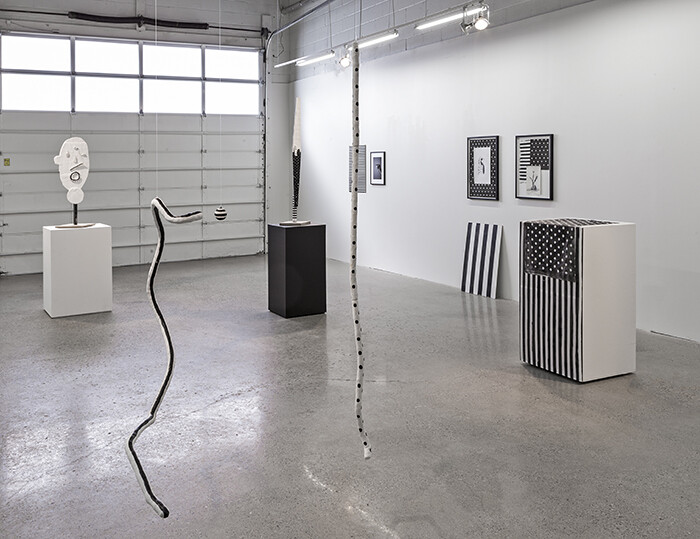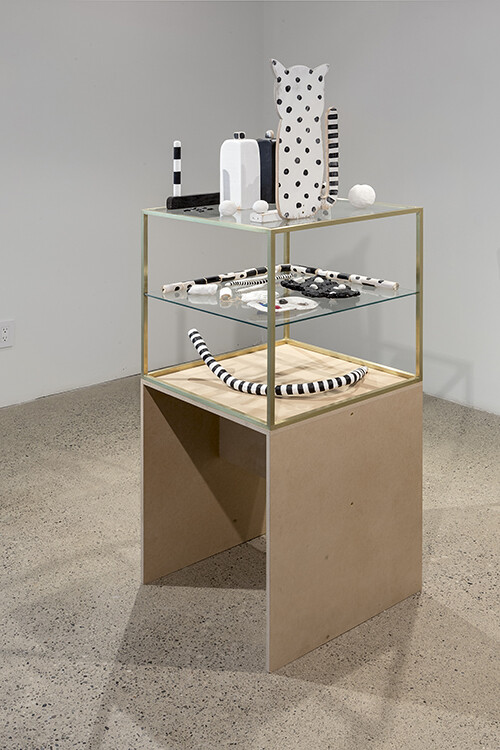“This is a dot. A dot is a sound. A dot is a sound in space. This is a dot in space…” This is the voiceover, augmented with psychedelic tonal music, which emanates from a speaker casually draped with hand-painted fabrics reminiscent of an American flag. The sonically infused gallery space is populated with paintings, drawings, photos, and sculptures by Canadian artist Zin Taylor—with each and every one of them featuring black-and-white stripes and dots. Based in Brussels for nearly a decade, Taylor has been gaining an increasing international reputation with exhibitions across Europe and North America. “The Story of Stripes and Dots (Chapter 7)” is now his fourth exhibition at Toronto’s Jessica Bradley Gallery, and is the latest in a series of shows in which he sets out to explore the cornerstones of both abstraction and figuration.
Taylor’s visual vocabulary is intentionally limited to black-and-white stripes and dots; however, it is the syntactical play of these elements in disparate contexts that energize his work. In contrast to the work of the modernist masters that comes to mind when one thinks of philosophies and hypotheses of abstraction—like Kazimir Malevich, Piet Mondrian, or Josef Albers, who each believed that their experiments in fields of color could be the foundation for a new society—Taylor’s inquiry into stripes and dots offers a lens for altering our perception of the world around us in a sprawling and seemingly endless play of associations, tangents, and hypotheses. In his work, we see that the line is the contour used to define a form, and the dot a point of pure pigment loaded with the potential to remain abstract or to become—even extend into—a line itself. These graphic elements allow him to filter perceptions through a set of identifiable symbols, and in turn, to render his ideas in sculptural form.
Modernist purity is also not Taylor’s primary interest. Instead, he describes lines (stripes in Taylor’s vocabulary) as stories—extending into time and space—and the dots as events—moments of action or expression—in an otherwise linear trajectory. One sees this quite clearly in A Structure Choreographed to Filter a Room (Fingers Pulled from the Sea and Patterned), 2nd arrangement, (2012), a three-part mobile hanging in the main gallery space’s entrance; its black-and-white stripes and dots introduce a key visual thread that runs throughout the entire exhibition. Bringing to mind the most famous of modernist mobile-makers, Alexander Calder—who once created an alphabetical index for shapes in his hanging sculptures so that they could be read(1)—the work consists of two long, serpentine sculptures made of PVC, plaster, and acrylic paint that twirl on their wires alongside a single, striped ball. Confronting us like a curtain at the entry to the space, these hanging sculptures not only assume the shape of two squiggly lines and a dot, but their surfaces are also painted with those patterns. Serving as a three-dimensional introduction to Taylor’s formal approach, their shape suggests the stylized representation of a snake hung by a leopard tail. Hung individually, these works, unlike Calder’s mobiles, are less concerned with their own gravity than with their relationship to the things around them.
Late German artist Martin Kippenberger has been a recurrent influence on Taylor. Both artists work is somewhat messy and at times libidinous (with lines and dots suggesting, for Taylor, the phallus and vulva). Indeed, Kippenberger’s own Metro-Net subway station in Canada’s Dawson City was the main subject of one of Taylor’s early video works, Put Your Eye In Your Mouth (2007) as well as Nook (2007), his photographic and text-based travelogue to the Metro-Net project. Here in this new installation, Taylor uses a symbolic system to interpret and see many everyday shapes and forms anew. Running along one of the gallery’s walls is Letterhead of Stripes and Dots (2013), a series of doodle-like drawings that have been folded into thirds and reopened like a letter. Reading as if they are part of a private conversation to which we are only partially privy, these Kippenberger-esque pen drawings offer an amusing means of encountering stripes and dots in everyday life, like seeing sushi as dots or looking at the stripes of zebras.
While the time for grand narratives such as “modernity” or “progress” may be over, it is through storytelling that we articulate our interpersonal relationships, justify pasts, and speculate about the future. Taylor’s exhibitions, or “chapters,” as he calls them, make use of a range of narrative conventions and devices, like voiceovers, recurrent characters (a Dalmation, or a tabby cat, for example), and props, which sit patiently in anticipation of action. The overarching or linear story is difficult, if not impossible, to fully grasp. Instead of offering a tale with a beginning, middle, and end, Taylor engages our imagination through processes of abstraction and speculation. Previous editions of “The Story of Stripes and Dots” have been presented in museums, public galleries, art fairs, and commercial galleries, and these different contexts inevitably alter the legibility of these stories and artworks —a quality not dissimilar to another artist synonymous with stripes: French postwar artist Daniel Buren.
Although the exhibition as a whole does not provide us with a coherent narrative—at least not a grand one, if any at all—and it might be tempting to view Taylor’s undertaking as simply derivative, it is the combination of all the objects in his installations, and the interweaving of idiosyncratic observations, that beckons to us. Guided as we were by the voice calling from the main gallery space on our way into the exhibition—it was easy for us to overlook a vitrine in a small room with the self-explanatory title, 24 Thoughts about Stripes and Dots made into forms and arranged upon a vitrine made of brass and glass (2012). But upon leaving the exhibition, it became clear that this work is the key to understanding the entire project’s narrative potential. Amongst those twenty-four objects on view are small jars, a small skull-like mask, a serpentine sculpture (much like the longer elements of the aforementioned mobile), a spotted wooden cat with a stripy tail, and many other curious objects, some of which are much harder to identify. Serving like a preface to the main exhibition, this “micro-narrative” looks like a stylized version of something you might find at an apothecary shop, where the performative and mystical side of Taylor’s enterprise comes to the fore. Much like other artists of his generation, including Laure Prouvost or Marvin Gaye Chetwynd (formerly known as Spartacus Chetwynd), the references to aesthetic traditions and their supporting theories and figures abound in his practice—including Dadaist collage, Surrealist performance, Minimalist painting; it is in Taylor’s unpredictable approach to strategies of appropriation and homage that his work comes to life.
1) Writer Zoë Gray makes this connection in a recent publication on Taylor’s work. Zoë Gray, “Fold Along the Dotted Line,” in Zin Taylor: Lichen Voices/Stripes and Dots, eds. Rosemary Heather and Nicolaus Schafhausen (Berlin: Fogo Island Arts and Sternberg Press, 2013), 68.











